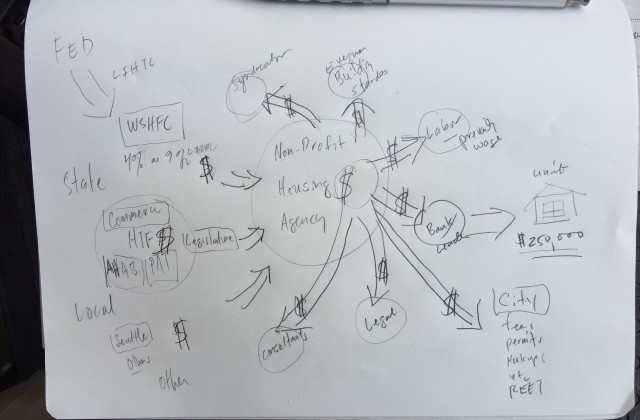No Progress on Reducing Non-Profit Costs
The Daily Journal of Commerce reported last week routine news: more money for non-profit subsidized housing.
SEATTLE — The Washington State Housing Finance Commission has approved nearly $269 million in financing for the new construction or preservation of 773 affordable apartments in Western Washington.
The five projects are in Seattle, White Center, Bellevue, Mill Creek and Monroe. They are financed by a combination of federal housing tax credits and tax-exempt bonds or notes.
Let’s do that math real quick; that’s $347,994.83 per unit. That’s about where I have pegged the average from analyzing years of funding from the State’s Housing Trust Fund (HTF). That’s an average, and some of these projects are outside Seattle where land prices are higher. Digging into the list of projects shows that the Washington State Housing Finance Commission (the Commission) put $174 million in tax credit equity into the projects, the remainder comes from other sources.
One Seattle project, the Encore Apartments, will produce 60 units of housing “in the shadow of the Space Needle” that “will serve people earning up to 60 percent of median income, including six units set aside for people with disabilities.” The price tag for the project is $20,700,000 or about $345,000 per unit. The income mix isn’t in the press release nor are the size of the units. Remember, 60 percent of Area Median Income (AMI) is about $42,150 for one person which is about $1,053.75 per month. That certainly is lower than the average Seattle rent by most estimates (anywhere from $1200 to $1800), but is still higher than someone earning 30 percent of AMI could afford.
By comparison, the for-profit developer that pointed out this allocation to me said that his project’s pro forma averages 625 square foot units for a total cost, including land at about $225,000 per unit. I’ve done these comparisons frequently before, and they always come up the same: for-profit builders build more units for less than non-profit housing providers. The excuses for this are endless. The non-profits get too much money and have too much political power. They also control the narrative, a story that is all about how “we need more affordable housing” instead of “we need more housing so that it is affordable”
So we simply haven’t made any progress on getting the non-profits to look at reducing these costs. Part of it is unit size. As I pointed out at Forbes, the price system ends up incentivizing smaller units. I don’t know the site where the 60 units are going to be built, but my hypothesis is that the units are much larger than they need to be regardless of the number of rooms they have. Even a 20 percent increase in units, 72 instead of 60, would mean a total development cost per unit of $287,500 about $60,000 less. How much would this push down rent? It’s hard to say without seeing the pro-forma, but it is also a good guess that rents in all the units could come down — and the waiting list would be shorter.
None of this seems to matter to the non-profits that have resolutely ignored the call to at least look at the regulatory costs they share with for-profit producers. The non-profits also have expressed zero interest in unit size as part of the answer. They’ve simply hunkered down, continuing to demand more and more money to solve their problems with rising development costs. The legislature didn’t seem interested in this either. In spite of the study we supported there was no action on improving or addressing costs or the disparity between rural Washington and Seattle.
What’s next? I’m not sure. Without political will, getting at costs is impossible. And as long as rising costs keep getting addressed with more and more fees, fines, taxes, and other exactions, then the price of housing will continue to rise, providing more rationale, ironically, for more fees, fines, and taxes. I’ve pulled out all the stops on this, trying without much success to build some momentum to take a harder look at costs working with various efforts and with legislation. Nobody seems interested. Perhaps with a new City Council there might be a change in focus. Who knows?


